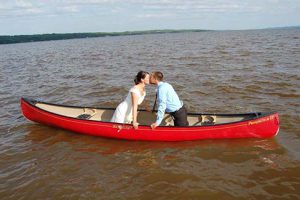
People & Culture
On thin ice: Who “owns” the Arctic?
As the climate heats up, so do talks over land ownership in the Arctic. What does Canadian Arctic Sovereignty look like as the ice melts?
- 4353 words
- 18 minutes
This article is over 5 years old and may contain outdated information.
People & Culture

This summer the RCGS-supported expedition Together to the Tundra spent two months canoeing through some of Canada’s most remote landscapes. Dan Clark, Alice Young Clark, their young children Koby and Ava Fei, and their friends Bruce Bembridge and Marilyn Toulouse paddled from Yellowknife, along Great Slave Lake and passed through the proposed Thaydene Nene National Park on the historic Pike’s Portage route. The expedition stretched over 1,000 kilometres. Here, Dan Clark tells one of their stories.
Water pours through the crumpled canoe. Our well-travelled vessel is on the bottom of the creek, deformed beyond belief. Moments before, in a narrow swift I could have waded, I lost control of the bow of the boat. It swung instantly into the current and caught on the far side. The force of the water folded it, and now the only thing holding it together is the spray cover. Everything else went in the water: all of our gear, weeks of food and the kids.
I try to take stock of the situation and sort through my inner turmoil. We are 42 days into the most vacant wilderness in Canada with 250 km of tough travel to the nearest road. If we can’t rescue the boat the trip is over and we will have to call a floatplane.
But in the here and now, responding to the situation starts with getting the kids into dry clothes and pulling gear out of the boat. Our friends Bruce and Marilyn jump in to help, but six-year-old Ava Fei is inconsolable because she lost her lunch bag and eight-year-old Koby because he lost a boot. We are all worried about the canoe.
Within a couple of hours we have bent the boat back into a workable shape and use cord to pull the gunnels together where they are broken. We feel like setting up camp and crawling into our sleeping bags, but the hummocky tundra offers nothing nearby. We do what we have done every other day of the trip – we paddle.
The hours that follow in the boat are therapeutic. The kids talk about their scary swim and how mama pulled them from the water. We analyze the mistakes, look at the positives, and decide what we will do differently in the future. We talk a lot about how we work together as a team and how our responses to challenges define who we are. [Get our tips for camping with kids here]
As the shock of the wreck wears off, our thoughts drift back to myriad fun moments from the first six weeks of the trip: fish we caught, playing the ukulele, bannock pizza, caribou antlers lying in lichen, fairy houses built by little fingers, the muskox herd, running naked on the beach, and picking an endless crop of ground-hugging blueberries.
By mid-afternoon we are feeling much better, and a short portage has us warm and dry. We consider setting up camp at the end of the portage; we have had more than enough adventure for the day. But a chill goes through me when I see a brown lump on the far side of the next lake. It is too far to tell what it is, even with the binoculars, so we reluctantly load the canoes so we can put some distance between us and what could be a grizzly bear.
As we paddle silently across the lake nervousness is replaced by the excited realization that the bear is actually a muskox. Near shore, we watch the lone bull slowly rise from his day bed in the shrubs and plod to the top of the esker. We revel is this rare moment, taking photos and hearing his snorts and the click of his hooves on the gravel. Our group of six sits in awe of this rare northern creature and minutes feel like hours. We are spellbound until he ambles out of sight.
We chatter about our good fortune, the intimacy of the experience, and about the unknowns around each corner in this tundra wilderness. We are struck by how a day can start so terribly and end so memorably.
Are you passionate about Canadian geography?
You can support Canadian Geographic in 3 ways:

People & Culture
As the climate heats up, so do talks over land ownership in the Arctic. What does Canadian Arctic Sovereignty look like as the ice melts?

Environment
The uncertainty and change that's currently disrupting the region dominated the annual meeting's agenda

History
Canadian Canoe Museum explores the link between paddling and romance

People & Culture
The story of how a critically endangered Indigenous language can be saved